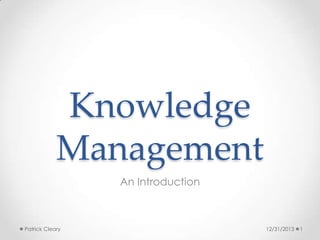Knowledge management
- 2. Knowledge Management Knowledge Management Definition The process of systematically and actively managing and leveraging stores of knowledge in an organization
- 3. Knowledge Management âĒ A robust Knowledge Management program helps your company: o Avoid reinventing the wheel, and build upon passed successes o Create an environment where learning and ideation is routine o Improve the speed of business o Promote a long term focus on developing the right competencies and skills o Protect key knowledge and competencies from being lost or copied
- 4. Knowledge Management Tools âĒ A sophisticated document repository to support client deliverable development, archive industry research, and build thought leadership âĒ Wiki for knowledge accumulation âĒ Forums to facilitate and capture dialogue
- 5. Knowledge Mapping âĒ Knowledge mapping is: o o o o o the field within knowledge management that studies ways to provide employees throughout an organization with customized knowledge maps to create insights and vision âĒ A knowledge map is: o o o o o o a presentation of (analyses of) knowledge available within an organization, possibly aggregated, contextualized, and appropriately visualized 5
- 6. Thought startersâĶ âĒ Let us think about knowledge content/assets in two categories: o Delivery: This may be the most pertinent category for our group, as we are regularly looking to leverage/adapt previous created assets to create client deliverables Thought Leadership: Extremely valuable for our group to leverage, however we many not have as much visibility into the creation, location, or ownership of these assets o Press Releases Pitch Decks Internal Webinars Industry Insight Briefs Proposals Delivery Project Briefs Statements of Work Best Practices Packaged Deliverable s Competitor s Work External Webinars Studies Thought Leadership & Research White Papers Case Studies Articles Bioâs / Experts Blog Posts 6
- 7. Knowledge Mapping Example âĒ What information will be housed in this knowledge management tool? 1. What content will you expect to share? a) b) c) d) With With With With one another? other teams? your customers? the general public? 2. What types of content do you generate? a) Are there multimedia requirements? b) Is there a level of security necessary for your content? 3. What templates need to be in place for your content? a) Who is responsible for keeping your content up to standard? 7
- 8. Knowledge Mapping Example Provide answers to the following questions: âĒ Management: o o Who has expert knowledge in subject X? Who is building up / wants to build up expertise in subject X? âĒ Resource Management: o o Which knowledge is required in project X, and at what level? What experience does knowledge worker X have in area Y? âĒ Knowledge Workers: o o Where can I find knowledge on subject X? Who have the best knowledge on subject X? 8
- 9. Knowledge Mapping Steps âĒ Identify additional people to be included in our mapping exercise âĒ Schedule knowledge mapping session âĒ Report back to key stakeholders âĒ Design & Implementation 9









